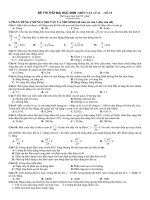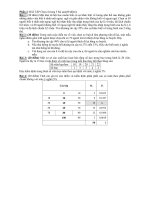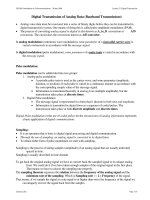LECTURE 15: Data
Bạn đang xem bản rút gọn của tài liệu. Xem và tải ngay bản đầy đủ của tài liệu tại đây (49.97 KB, 7 trang )
CSN200 Introduction to Telecommunications, Winter 2000 Lecture_15 Data, Encoding and Transmission
Data:
What is Data?
Any meaningful information is data.
Otherwise it is noise or nonterrestrial data.
Data in Electronic form:
Any meaningful information can be represented into
Electrical,
Electromagnetic or
Optical form
for the purpose processing, storing and transmission.
Electronic Data can be of two kind:
Analogue and
Digital
Analogue Data - take on continuous values as time changes. E.g.,
Voice - uses microphone to convert to electrical form
Video - uses video camera
Temperature - uses sensor, like thermocouples
Pressure - uses piezoelectric crystals
Digital Data - take on discrete values, switching ON/OFF, text, integers, etc.
Can be grouped into
Bits - either a voltage or no voltage, 0 or 1
Bytes - group of 8 bits, like 0100 0001 is A in ASCII code
What is Data (2nd time)?
Normally we mean digital data processed by a computer.
Signals:
In a communication system, data are propagated from one point to another by means of
electromagnetic signals. A signal is a series of analogue or digital data. That is a varying voltage
(either continuous or discrete) with time in an electronic communication system.
Definitions of Data and Signals:
Analog Data - Data represented by a continuous physical quantity whose magnitude is proportional to
a suitable function of the data (information). It can have more than two discrete values in
contrast to digital data.
Digital Data - Data represented by discrete values or conditions.
Analogue Signals - A continuously varying electromagnetic wave that may be propagated over a
variety of media. A series of Analog data.
Digital Signal - A discrete or discontinuous signal, such as a sequence of voltage pulses. A series of
digital data or bits.
(Ref: Fig 5.1 ,4.2, 4.7, 4.10 Slyke)
Lecture15.doc Page 1 (7)
CSN200 Introduction to Telecommunications, Winter 2000 Lecture_15 Data, Encoding and Transmission
Encoding:
The simplest end-to-end data communications session between two PCs:
PCs are digital electronic systems.
PCs processes data in digital format (discrete voltages of electricity).
To process or transmit data by the machines, it must be transformed from its humanly
understandable form (letters, numbers, voice, images) to an electronically (digital) based
machine-understandable form.
Character Encoding:
The process of transforming humanly readable characters into machine-readable code is known
as character encoding.
In this process, characters are turned into a series of 1s and 0s.
Why 1s and 0s?
Digital electronic system processes information (operates) by discrete voltages of electricity.
These discrete voltages of electricity (2.8v and 0v) representing coded characters can
then be processed and transmitted. The 1s and 0s are used as symbols to represent two
discrete states.
Characters can be encoded according to variety standards:
ASCII (American Standard Code for Information Interchange) code uses 7 bits; used in
PCs.
EBDIC (Extended Binary Coded Decimal Interchange Code) uses 8 bits; used IBM
mainframes.
Unicode and ISO10646 use 16bits; Windows NT supports Unicode.
Digital Encoding of Digital Data: (p. 108)
Unipolar (the voltage always positive or negative, 0v for 0 and 5v for 1)
Bipolar (fewer errors than unipolar signaling as changing the polarity of a current/voltage is more
difficult than changing its magnitude, -5v for 0, +5v for 1)
RZ (return to zero)
NRZ (non return to zero)
NRZ-L (NRZ, level)
NRZ-I (NRZ, invert on ones)
Biphase (all of the biphase techniques require at least one transition per bit time and may have as many
as two transitions.
Manchester (used in Ethernet LANs) - The midbit transition serves as a clocking
mechanism and also as data.
0 - a high-to-low represents a 0, and
1 - A low-to-high represents a 1.
Differential Manchester (used in Token-ring LANs) - The midbit transition is used
only to provide clocking.
0 - A transition at the beginning of the bit period represents 0, and
1 - an absence of a transition at the beginning of the bit period represents 1.
(Figure 4-3, p-111, Dennis; Figure 5-5, p-105, Slyke)
Lecture15.doc Page 2 (7)
CSN200 Introduction to Telecommunications, Winter 2000 Lecture_15 Data, Encoding and Transmission
Data Transmission:
Data transmission is the transfer of data between two electronic system on a suitable media.
Both analog and digital data can be represented and propagated by either analog or digital
signals.
Both analog and digital signals can be transmitted on suitable media.
Analog transmission - is the transmission of analog signals.
Analog signals may represent either analog (voice) or digital (text) data.
Digital transmission - is the transmission of digital signals.
Digital signals may represent either analog (voice) or digital (text) data.
(Ref: Table 5-1 Slyke)
Four possible combination of data and transmission:
Digital data, digital signal.
In general, the equipment for encoding digital data into a digital signal is less complex than
digital-to-analog equipment.
Analog data, digital signal.
Conversion of analog data to digital form permits the use of modern digital transmission and
switching equipment.
Digital data, analog signal.
Some transmission media, such as optical fiber and satellite, will only propagate analog signals.
Analog data, analog signal.
Analogue data are easily converted to an analogue signals.
Advantages and disadvantages of analog and digital transmission:
• Digital signal suffer more from attenuation than do analog signals.
• Digital signal can be propagated only a limited distance before attenuation endangers the integrity
of data.
• Analog signal can be transmitted to longer distances.
• Analog transmission is affected by noise.
• Digital signal can only be transmitted through Copper media.
• Analog signal can be transmitted through Copper, Fiber and Satellite.
Lecture15.doc Page 3 (7)
CSN200 Introduction to Telecommunications, Winter 2000 Lecture_15 Data, Encoding and Transmission
Parallel vs. Serial Transmission:
Parallel:
In parallel transmission all bits in a single character are transmitted simultaneously.
Data travels in parallel (simultaneously) within a PC over the data bus (bundle of data lines).
Similarly we can transmit data between two PCs in parallel.
That is all data lines (normally 8) from one PC are connected to the other PC.
Parallel transmission is primarily limited to transmission of data within a computer, between
computers and between a computer and a printer.
It is fast compared to serial transmission but limited to shorter distances.
Serial:
In serial transmission bits are transmitted in a linear fashion, one after the other.
It is slower but can travel longer distances and is widely used.
Serial and Parallel Transmission (p. 109)
Serial Transmission is the predominant method of transferring information in data communications.
Data bits are sent serially or sequentially bit-by-bit over a single wire or
communications circuit. Sending bits one after another is slower than sending
them in parallel but most long-distance circuits only allow serial transmission.
It is the mode of communication used on a PC’s serial port as well as on local
area networks.
Parallel Transmission sends data bits in parallel (typically 8 bits at a time) using separate wires or
circuits for each bit. This “byte-wide” transmission is faster than serial
transmission but requires more wires in the cable and can not be used over
long distances. It is not used very often in data communications but is used
extensively for computer busses and for printer connections.
(Figure 4-1, 4-2, p-110)
Reception of Digital data:
The reception of digital data involves sampling the incoming signal once per bit time to
determine the binary value (0 or 1).
To get the data correctly the receiver must know the arrival time and duration of each bit that
it receives.
One of the reasons is that all the digital system operates in steps with a stepper (also called a
clock, which creates a stream of pulses).
If the receiver's clock drifts by 1% and the transmission rate are 10 kbps, reception of a long
stream of bits will go out of step and cause erroneous reception.
Effect of noise on a digital signal:
The erroneous reception is also caused by the transmission impairments.
Within any communication system, the signal that is received will differ from the signal that is
transmitted, due to various transmission impairments (attenuation, delay, noise, etc).
Lecture15.doc Page 4 (7)
CSN200 Introduction to Telecommunications, Winter 2000 Lecture_15 Data, Encoding and Transmission
Asynchronous and Synchronous Transmission: (p. 148)
The timing difficulties in data transmission can be avoided as follows:
arrival time of a bit or packet - avoided by sending start/stop bits or start/stop preambles, and
duration of each bit- avoided by synchronizing the clocks at both end, i.e., sampling the data at the
right time.
Two approaches are common for achieving the correct data. The first is called the asynchronous
transmission and the second one is the synchronous transmission.
Asynchronous transmission:
The strategy with this scheme is to avoid the timing problem (associated with the drifts of the clock
speeds at two ends) by not sending long, uninterrupted streams of bits.
Instead, data are transmitted one character at a time, that way timing or synchronization are maintained
within each character.
That is done by synchronizing at the beginning of each new character, using start and stop bits.
Though both the transmitter and the receiver agree upon one transmission speed, their bit time may
vary slightly. But this slight variation will not affect the reception of a few individual bits.
Asynchronous transmission is achieved by stoping the transmission before the error occurs because of
timing drifts. In Asynchronous transmission a maximum of 9 bits are transmitted between each
pair of start and stop signals.
Asynchronous transmission requires 20% or more overhead (a waste of 2 bits for every 10 bits of
transmission (1 start + 8 data + 1 stop). The solution is the synchronous transmission.
(Figure 5-8, p-148)
• Asynchronous Transmission involves sending each character (or byte) with its own start and stop
bits.
• Asynchronous means not synchronous or unsynchronized. The start bit tells the receiver to
expect a new character.
• Keyboard input is asynchronous as is all transmission from a serial port.
• It is also called “character-framed” data.
• It is inexpensive and often used for low speed connections of PCs or terminals to mainframe
computers or other full duplex point-to-point circuits.
• When the sender is waiting for the next character to be sent, the line is idle and remains in its
default state which is the same as the stop bit state (binary 1 or -12v in case of serial port
transmission).
Lecture15.doc Page 5 (7)









